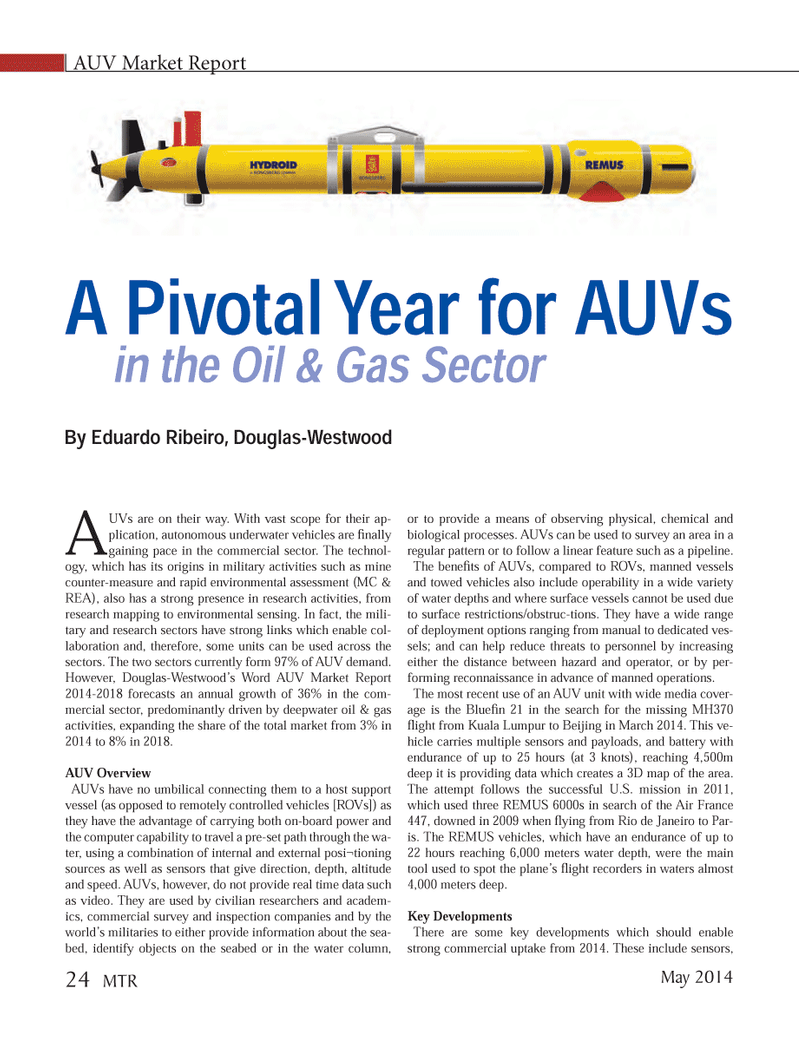
Page 24: of Marine Technology Magazine (May 2014)
AUV Operations
Read this page in Pdf, Flash or Html5 edition of May 2014 Marine Technology Magazine
AUV Market Report AUVs are on their way. With vast scope for their ap- plication, autonomous underwater vehicles are Þ nally gaining pace in the commercial sector. The technol- ogy, which has its origins in military activities such as mine counter-measure and rapid environmental assessment (MC & REA), also has a strong presence in research activities, from research mapping to environmental sensing. In fact, the mili- tary and research sectors have strong links which enable col- laboration and, therefore, some units can be used across the sectors. The two sectors currently form 97% of AUV demand. However, Douglas-WestwoodÕs Word AUV Market Report 2014-2018 forecasts an annual growth of 36% in the com- mercial sector, predominantly driven by deepwater oil & gas activities, expanding the share of the total market from 3% in 2014 to 8% in 2018.AUV Overview AUVs have no umbilical connecting them to a host support vessel (as opposed to remotely controlled vehicles [ROVs]) as they have the advantage of carrying both on-board power and the computer capability to travel a pre-set path through the wa- ter, using a combination of internal and external posiÂtioning sources as well as sensors that give direction, depth, altitude and speed. AUVs, however, do not provide real time data such as video. They are used by civilian researchers and academ- ics, commercial survey and inspection companies and by the worldÕs militaries to either provide information about the sea- bed, identify objects on the seabed or in the water column, or to provide a means of observing physical, chemical and biological processes. AUVs can be used to survey an area in a regular pattern or to follow a linear feature such as a pipeline. The beneÞ ts of AUVs, compared to ROVs, manned vessels and towed vehicles also include operability in a wide variety of water depths and where surface vessels cannot be used due to surface restrictions/obstruc-tions. They have a wide range of deployment options ranging from manual to dedicated ves- sels; and can help reduce threats to personnel by increasing either the distance between hazard and operator, or by per- forming reconnaissance in advance of manned operations. The most recent use of an AUV unit with wide media cover- age is the BlueÞ n 21 in the search for the missing MH370 ß ight from Kuala Lumpur to Beijing in March 2014. This ve- hicle carries multiple sensors and payloads, and battery with endurance of up to 25 hours (at 3 knots), reaching 4,500m deep it is providing data which creates a 3D map of the area. The attempt follows the successful U.S. mission in 2011, which used three REMUS 6000s in search of the Air France 447, downed in 2009 when ß ying from Rio de Janeiro to Par- is. The REMUS vehicles, which have an endurance of up to 22 hours reaching 6,000 meters water depth, were the main tool used to spot the planeÕs ß ight recorders in waters almost 4,000 meters deep.Key Developments There are some key developments which should enable strong commercial uptake from 2014. These include sensors, A Pivotal Year for AUVs A Pivotal Year for AUVs in the Oil & Gas Sector in the Oil & Gas Sector By Eduardo Ribeiro, Douglas-Westwood By Eduardo Ribeiro, Douglas-Westwood 24 MTRMay 2014MTR #4 (18-33).indd 24MTR #4 (18-33).indd 245/12/2014 10:49:31 AM5/12/2014 10:49:31 AM

 23
23

 25
25
